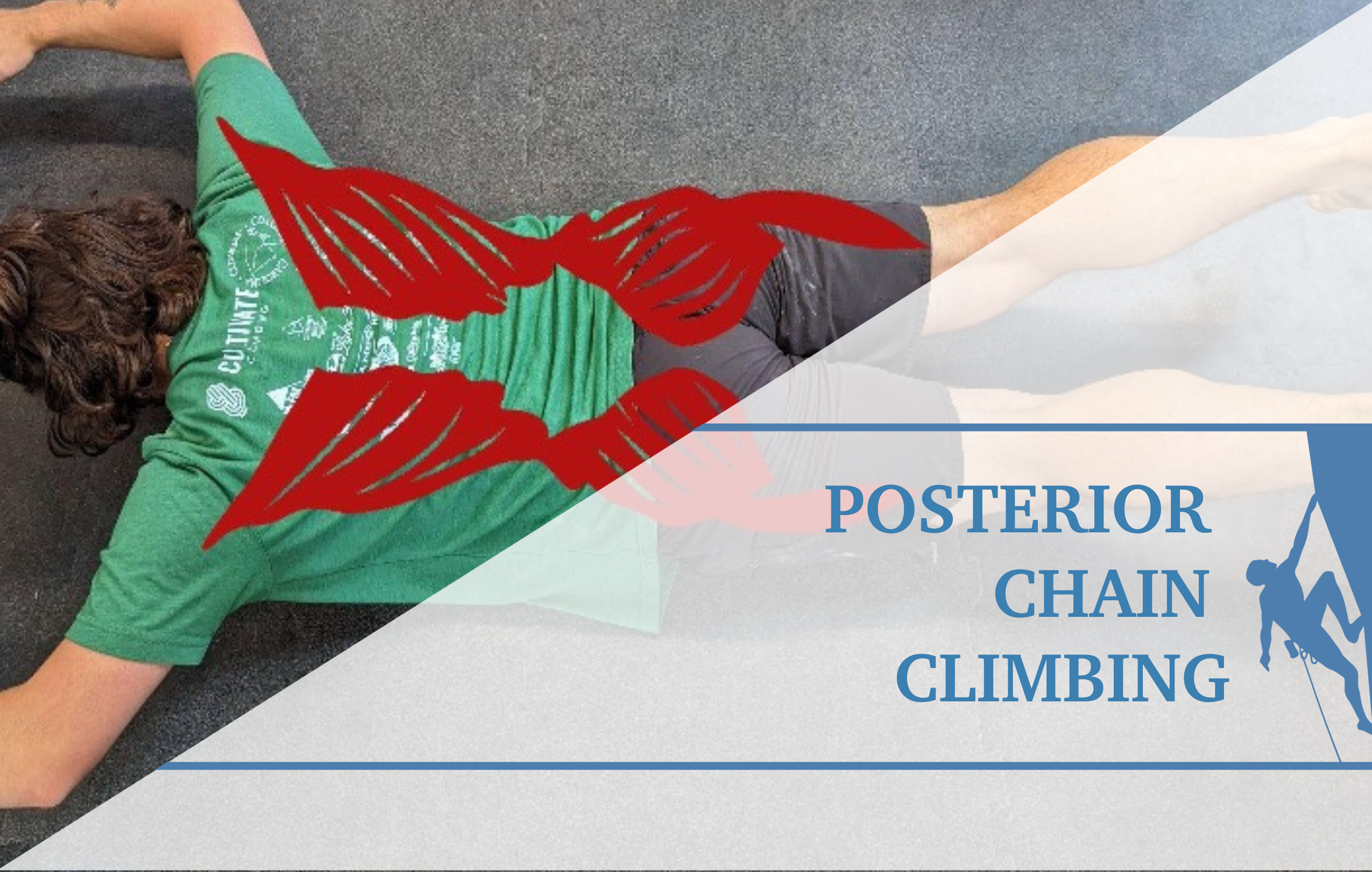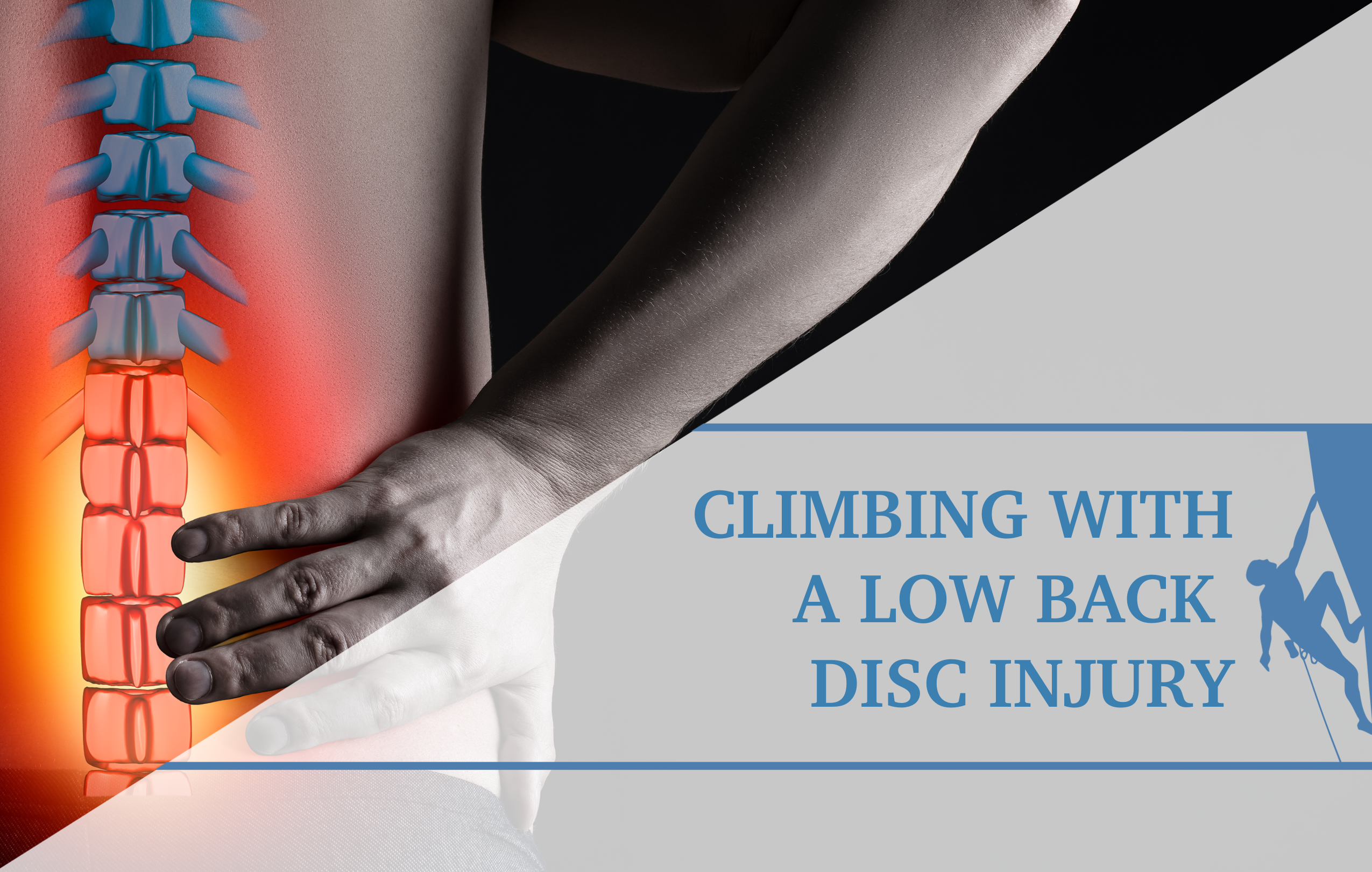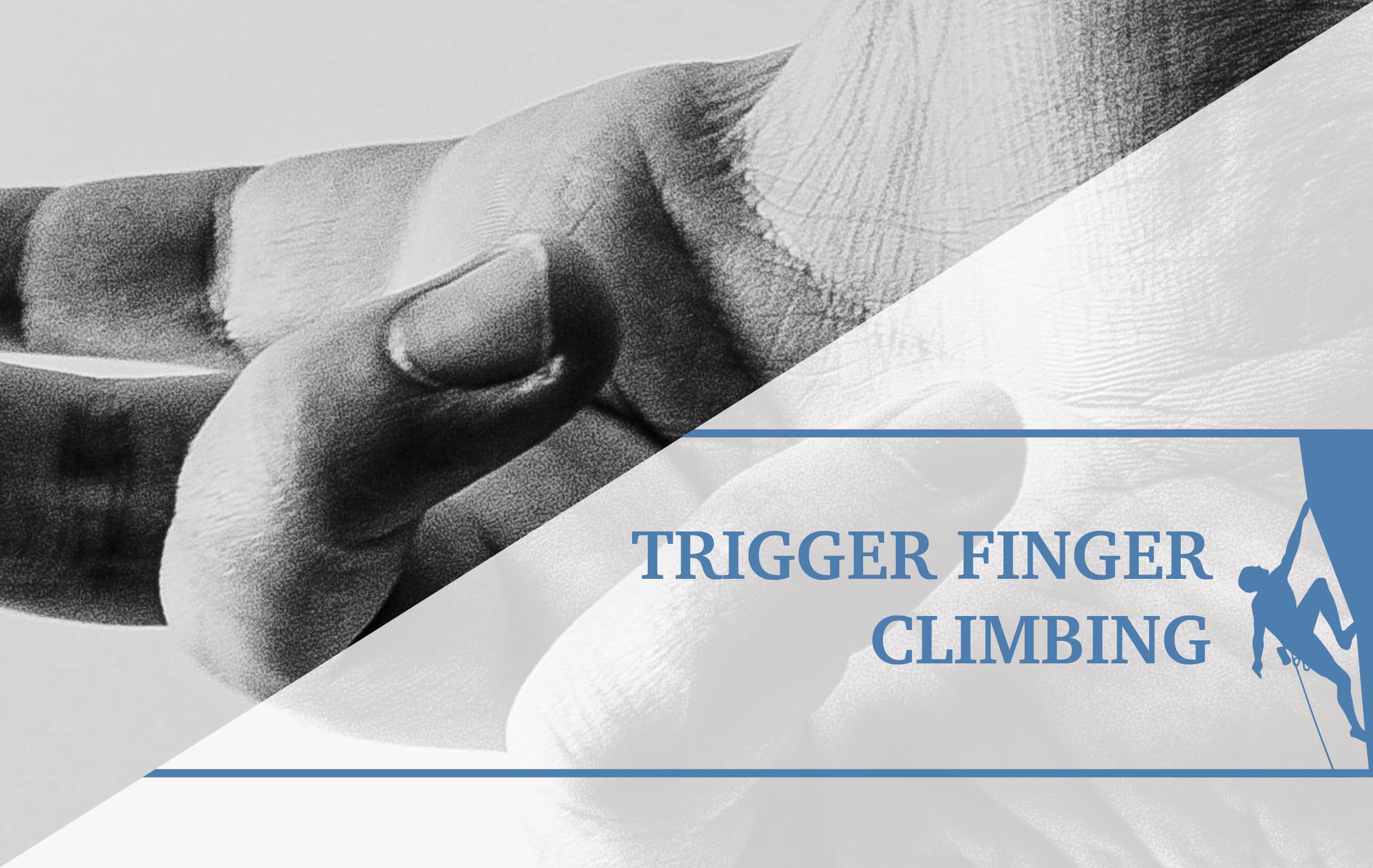Low Back Injuries in Boulderers
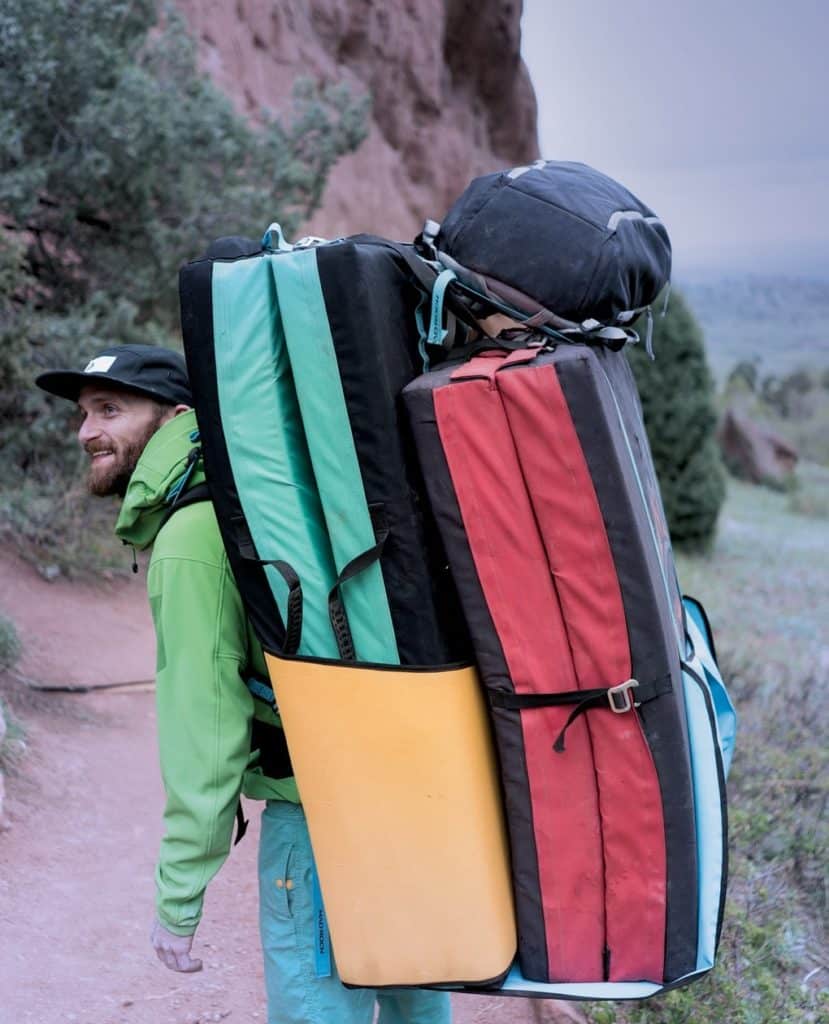
Moja Gear. Review of New 2017 Mad Rock Duo Pad. Accessed 2021-01-15.
https://mojagear.com/wp-content/uploads/2017/08/duo_lifestyle2-min.jpg
Introduction
You’ve finally finished packing your car for that big camping and climbing trip and cannot wait to get on the road to the campground.
After a 4 hour drive, you start to pull up to the campsite and notice the sun is starting to go down and you’re hoping to squeeze out a couple of problems on the nearby boulders. You first notice your back is stiff from the drive but you quickly forget as the hype grows in the air.
As you load up your crash pads, shoes, snacks, some extra clothes and flashlights, you and your climbing squad head out into the sunset with unwavering excitement. By the time you find the problem from your phone’s GPS coordinates, you realize you don’t have time to warm up so you set up your crash pads below. As you bend over to put on your shoes, you notice a slight twinge in your lower back, but pay no mind as you start your first climb. As you approach the top of the problem and come to a small overhang, you decide to send it and you end up missing and fall to your feet on your crash pad below. You don’t think too much of it at first, but as you head into your next climb you start to notice some pain coming from the left side of your low back as you navigate the same small overhang. You finish the problem this time, but by the time you finish your down climb, you are already starting to become stiff and find that you can’t even take off your shoes. What happened? Could this have been prevented?
Unfortunately this scenario is all too familiar within the outdoor bouldering community. Many climbers have started to venture out further into the backcountry on overnight trips to find new and exciting routes, carrying 40-pound overnight packs with a crash pad haphazardly strapped to the outside of the pack. Maintaining good posture during climbs and using your legs to absorb shock when landing on a crash pad are both often overlooked aspects to begin with, but become recipes for disaster when combined with muscle fatigue from hauling heavy gear for miles.
Signs and Symptoms of Acute Low Back Injury
The first thing you may notice is that your lower back will start to stiffen up and it might be painful to bend forward, backward, or look over your shoulder. At this point you will want to stop all strenuous activity, including climbing and avoid carrying your heavy backpack. If you have any numbness, tingling, sudden loss of strength in your legs then it is important to seek a medical professional immediately as these could be signs of more serious injuries. If your pain is localized to your lower back region and does not travel down your leg or up your upper back and neck, then it is likely you have a muscle strain or joint inflammation. The important thing is to not overdo it at this point in time, avoid foam rolling and stretching for the first few days to let your symptoms go down. Typically acute low back injuries can be relieved in one of two positions of comfort, flexion or extension. Finding out which position relieves the pain will guide the first few steps of your recovery process.
If you have a flexion bias, you will likely find relief in sitting, lying down and when bending forward. This means that you likely hyperextended your lower back and put excessive stress on the ligaments and joints of the spine.
If you have an extension bias, which is generally more common, then you will probably have relief when standing, lying on your stomach or bending backwards. This is likely due to a hyperflexion injury in which your lumbar spine flexed forward too much and put stress on your discs and muscles.
For the next 24-48 hours, spend extra time in your position of comfort and your symptoms should start to decrease gradually. You will be tempted to climb and try “easy problems” with your friends but this is not a time to be pushing it and allowing your body to rest now will aid in tissue healing and ultimately less time to recover.
Assessing Underlying Causes of Low Back Pain
Low back pain in boulderers typically stems from a combination of underlying causes instead of one specific problem. Over time, these things in combination can lead to muscle strains, joint inflammation and even aggravated discs when triggered by carrying a heavy pack or a bad landing on a crash pad. What could be going on?
- Decreased activation and strength of core and low back muscles
- Weak glutes lead to overuse injuries of lower back muscles
- Decreased mobility of neighboring joints such as shoulder, hips and upper back causes excessive strain on lower back
- The climber is not conditioned to heavy compressive loading of the spine
Let us dive deeper into how to assess which categories you may fall under:
- Decreased strength of core musculature
The core muscles help protect the spine from external loads and assist in efficient movement especially for climbers. An easy and simplified way to think about the core is breaking it up into anterior (front) and posterior (back) portions. The anterior is composed of abdominal muscles , some of which flex the lumbar spine and prevent excessive extension, while others are key stabilizers to prevent unwanted movements. These muscles include rectus abdominis, transverse abdominis and obliques. The posterior is composed of lumbar extensors such as the larger spinal erectors and the smaller local stabilizers such as the multifidus, which together will help prevent excessive forward flexion of the spine. If the stability of either of these two muscle groups are compromised, then there can be a “breakdown” of your core causing tissue stress and could lead to more serious injuries down the road.
To find out if you may have less than optimal core strength, try these two exercises below as a baseline assessment.
Dead Bug Assessment
Tests lumbar flexor activation and stability in a stable and supported position

Bird Dog Assessment

Note: If you are having trouble maintaining a good neutral spine during these two exercises, it is likely that your anterior core muscles are not strong enough or do not have enough stability to maintain a good contraction as the arms and legs move independently. The ability to have proximal stability of the core combined with distal mobility of the arms and legs are crucial to pain-free climbing.
- Weak glutes can contribute to persistent low back pain
When we walk or hike, our glute muscles help to stabilize our pelvis and prevent excessive strain on our lower back muscles. When jumping and landing on a crash pad, the quadriceps and gluteal muscles are primarily responsible for slowing down the body and absorbing the impact. If you do not have enough strength or endurance of these muscles, excessive stress can be placed on your lower back after repeated falls and landings.
The other muscle often overlooked is gluteus medius. The gluteus medius is a hip abductor but also plays a crucial role in stabilizing the pelvis when walking, hiking or standing on one leg. If the gluteus medius is not able to perform its role effectively as a pelvic stabilizer, another muscle in the lower back called the quadratus lumborum (QL) will typically try to take over to keep the pelvis level, resulting in the muscle becoming overworked over time. If the QL is weak and unable to correct the level pelvis, then ultimately both the gluteus medius and QL become overstretched, making it more difficult to activate and strengthen.
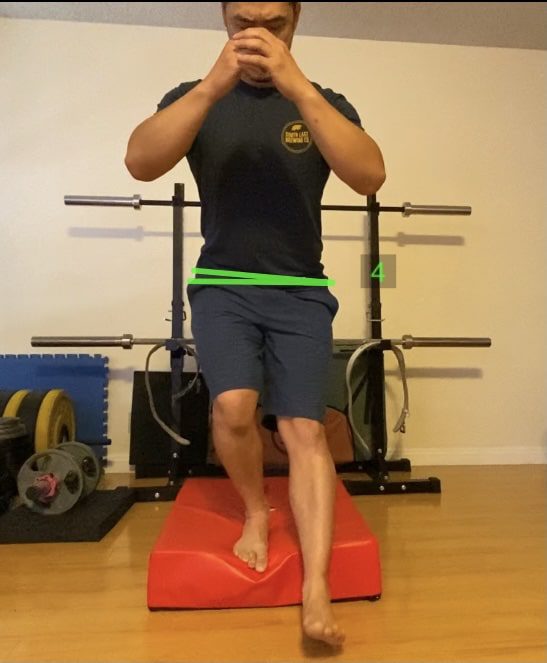
CORRECT

INCORRECT
Note: This test is useful in determining if your gluteus medius has enough strength and endurance. First you want to be able to obtain the initial start position. Then, the goal is to hold isometrically for as long as possible before fatigue or lower back compensation sets in. If you are unable to obtain the start position or feel that you are using only lower back muscles to hold the position, then you may have weakness in your Gluteus Medius muscle.
- Decreased mobility of neighboring joints
If you do not have sufficient mobility of your shoulders, upper back and your hips then your lower back ends up taking all of the responsibility. Your body will find the path of least resistance and it turns out that the lumbar spine is already one of the most mobile parts of our bodies. Therefore it is crucial to build lumbar stability while promoting mobility of neighboring body regions to promote balance and avoid injury. When imbalances do occur, we refer to this as upper crossed and lower crossed syndrome.
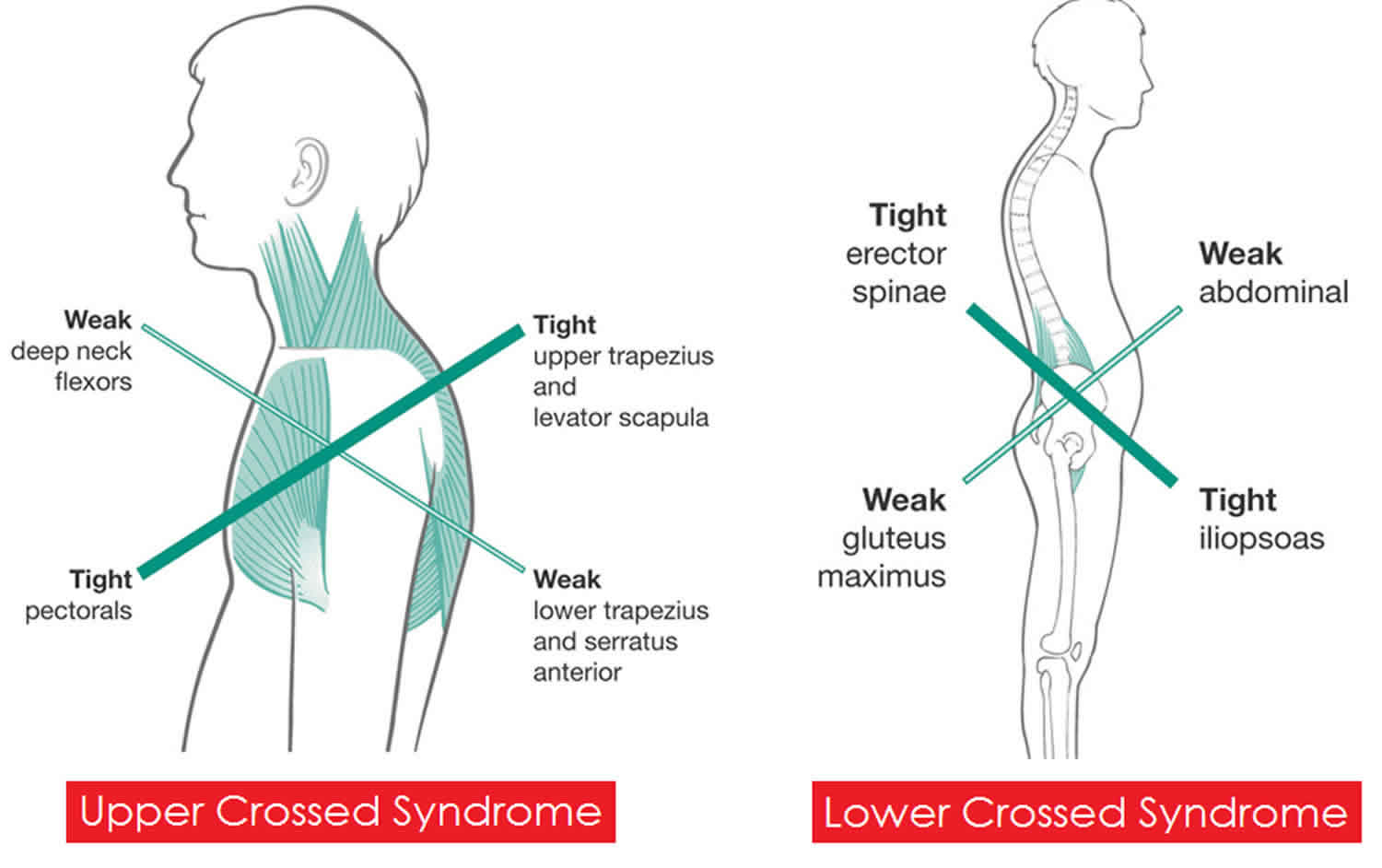
source: https://healthjade.net/cross-syndrome/
To determine if you have upper or lower crossed syndrome, the overhead wall sit assessment is a good test because it tells us a lot of information and is fast to perform. This test is very close to a typical wall sit that most of us are familiar with, except that the hands are overhead and the goal is to squeeze your ears but still touch the wall with your arms.

CORRECT

INCORRECT
You should try to accomplish three things:
- Head, upper back and glutes in contact with wall
- Arms overhead and touching the wall
- No more than a palm spacing between lower back and the wall
If you are unable to do all of these items with relative ease, then it is likely that you will compensate with excessive bending at the lower back. In fact, if you cannot do either 1 or 2 effectively, then you may end up over-extending your lumbar spine.
- The climber is not conditioned for heavy loads
When you wear a 40+ lb pack on your back, your center of mass is shifted backwards and therefore there needs to be a correction in order to maintain a neutral spine. If your trunk and lumbar flexor muscles are weak, then your body will rely on passive stability from the small ligaments in your spine and over time this can lead to excess stress and likely pain. Even with proper muscle activation, compressive forces on the spine are unavoidable and therefore need to be trained and conditioned over time to prevent injury.

CORRECT

INCORRECT
The first step is to assess standing posture with and without a backpack on. Start with filling a backpack with pillows or other light but bulky materials such as your puffy belay jacket and take pictures for comparison. Although we are more concerned with lower back posture, improper upper back position can and will ultimately lead to inefficient positions of the low back and therefore cannot be ignored. For example, if your upper back cannot support the added load of your climbing and camping gear, this could cause you to round forward and put excess stress on your lower back and hips. In addition, it becomes easier to lose a neutral and strong position when moving around with a heavy pack.
So, how do you know if you need to be conditioned for compression forces on your low back?
First, see if you’re able to stand comfortably with the pack. Do your symptoms get worse the longer you have the pack on? If so, this may indicate that you have not gotten used to hauling heavy and odd shaped objects for longer periods of time. Generally, if you do not spend much of your life carrying weighted objects around, then you would likely benefit from progressive loading with heavier objects once your symptoms have improved or resolved. For these exercises, it would be particularly important to take appropriate rest in between repetitions but also between training sessions.
The Rock Rehab Pyramid
Now that things have calmed down a bit, it is time to start looking ahead towards rehab and prevention. Dr. Jared Vagy in his book Climb Injury Free discusses the Rock Rehab Pyramid as a foundational concept to managing a variety of musculoskeletal injuries that climbers commonly face. The exercises below are broken up into four categories of unloading, mobility, strength and movement. Using this method will not only address your current injury and associated symptoms but also provide exercises to guide prevention of future injuries.
The Rock Rehab Pyramid was developed by Physical Therapist, Dr. Jared Vagy in his book Climb Injury-Free. This pyramid aides in the rehabilitation of climbing injuries by providing a system of four major categories that will guide the climber’s recovery process. Following an injury, one will start at the bottom of the pyramid and work upwards using general guidelines to determine appropriateness for progression to the next level.
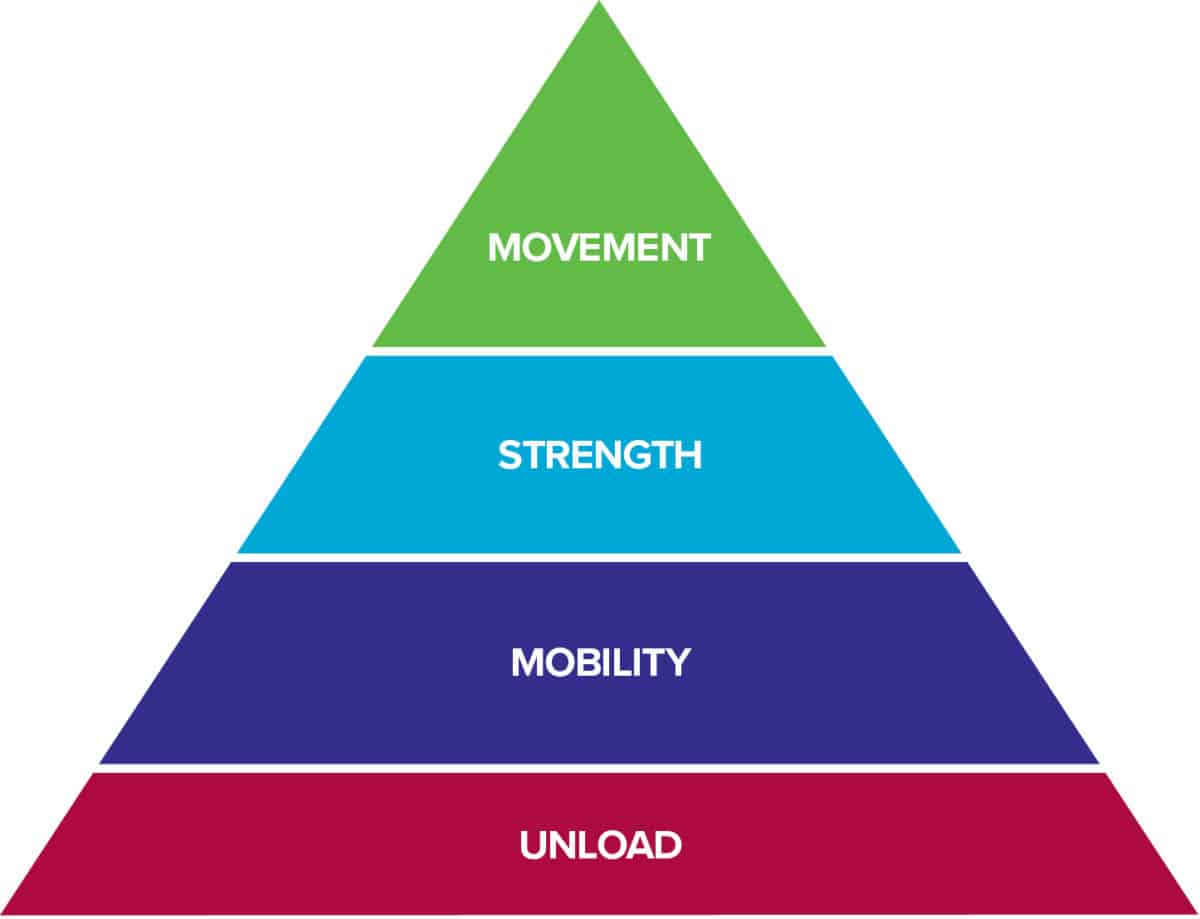
The bottom level of the pyramid aims to Unload the tissues in the body so that they have the best healing environment. Often times, after an injury there is some sort of change in Mobility. After the tissues have calmed down from the previous level, this stage will look to reestablish normal, pain free range of motion. Once the injured area restores its mobility, it is time to increase the Strength of the surrounding muscles so that Movement in the following level can be coordinated and optimized. Click here to learn more about the rock rehab pyramid structure.
Unloading Phase
Step 1
Avoid climbing, carrying heavy loads and spending time in aggravating positions. Rest for at least 1-2 days following injury and reassess symptoms after a couple of days. It is not uncommon for pain to get worse for the first 1-2 days but if pain is progressively worsening after the first week, then seeking a physician is likely indicated. Foam rolling or excessively stretching during this time is not recommended.
Step 2
Spend extra time in positions of comfort. As mentioned previously, this could either be flexion bias such as sitting and bending forward, or extension bias such as lying down on your stomach and even standing.
Diaphragmatic breathing exercises are also great for developing a stable core. To do this, place one hand on your chest and one hand on abdomen, inhale deeply through your nose for 5-10 seconds focusing on feeling movement in the hand on the abdomen and minimizing movement from the hand on the chest. Perform for up to 10 minutes or until relief of symptoms.
Step 3
After the first week or when symptoms subside, perform low intensity core activation exercises such as the dead bugs and bird-dog assessments above. These exercises are a great place to start and once you’ve mastered these with no pain, then it is time to progress to mobility and strengthening.
Mobility Phase
After resting for 1-2 weeks, it is likely your symptoms have reduced to a point where you can begin working on dynamic range of motion without pain. Perform these exercises exclusively for 1-2 weeks until you see an improvement in mobility. These exercises will help prepare you for the upcoming strength phase.
Thoracic Spine Mobility Drills
1. Quadruped Cat Cow Stretch – 8-12 repetitions, 2x/day, 4x/week
Alternate going between full extension and full flexion of your spine. Perform in a slow and controlled manner, breathing with each repetition.
2. Prone Shoulder Extension/external rotation exercise – 30-60 seconds, slow and controlled, 4x/day, 4x/week
Begin by lying face down and lift chest and head off of the floor while engaging abdominals. Lift your arms behind your body bring them overhead in a circular motion, slowly returning to original position.
3. Open Book Thoracic Spine Dynamic Stretch – 12 repetitions per side 2x/day, 4x/week
Begin in Half Kneeling and place hands together in front of you. Rotate through thoracic and lumbar spine, attempting to maintain a static hip position.
90-90 Dynamic Hip Stretch
Try to keep both needs in contact with the floor and the goal is to sit back into the floor gently. This stretch can be performed static or dynamic. Perform 5 reps alternating to each side, 3x/day for 4x/week.
Strength Phase
Weeks 1-2
Begin performing low load motor control exercises for the core and open up those tight hips and improve stability and control with these exercises and drills below. The key to these exercises are control, so performing them slow and with purpose will be most beneficial.
Core Stability and Motor Control
1. Dead Bug – 4×12 each side, 4x/week
Great Exercise for core stability while hip and shoulder joint goes through active range of motion. Start with feet only if coordinating arms and legs are difficult. Maintain low back contact with floor at all times.
2. Single Knee to Chest – 4×12 each side, 4x/week
Begin in Pushup position and bring alternating knees to chest while maintaining flat low back.
3. Bear Crawls – 4×5 steps forward and back – 4x/week
Start in quadruped position with hands and knees on the floor. Lift both knees off slightly. Slowly lift opposite hand and foot and walk forward without rocking back and forth. Maintain flat low back at all times.
Hip Stability Exercises
1. Clamshells with band – 3×12-15 reps, 3x/week
Begin in side lying with a resistance band around the knees. Slight bend at the hips and spread the band apart, keeping heels together.
2. Super Clams – 3×8 reps, 3x/week
Similar to the clamshell but bottom leg will push up against the floor as well, continuing to spread band apart.
3. Hip Airplanes – 5 reps each leg, 2x/day for 4x/week
Begin in a Romanian deadlift position using hands to balance as needed. Lift one leg off the floor and then with the leg that is balancing, turn the body and open the hips slowly and controlled. Return back to original position with control as well, maintaining neutral spine.
Weeks 3-6
Now that you have begun working on low intensity strength and motor control exercises for core and hip stabilizers, begin adding in higher load strengthening of upper back, low back, glute and hamstrings, all of which are important posterior core stabilizers. Continue performing mobility exercises at least 3 times a week during this time.
Rowing Variations for Upper Back Strength
1. Cable Rows- 4×12, 2x/week
Squeeze shoulder blades and pull arms to your stomach. Avoid shrugging upwards or leaning back too far.
2. Inverted Rows – 4×8, 2x/week
This can be performed on rings or TRX straps. Elevate feet on a small box or ledge, maintaining neutral spine and head alignment, pull chest towards hands. Slowly lower back down.
Glute Max and Hamstring Strength
1. Step up with contralateral DB Loading – 3×12 each leg, 3x/week
Step up onto a 12 inch box with one leg, then slowly lower back to the floor in a controlled manner, engaging glutes and quads at all times. Add a weight in the opposite hand to increase difficulty as needed.
2. Romanian Deadlift – 4×8, 2x/week
Maintain a slight bend in your knees and hinge at your hips, lowering barbell to mid shin slow and controlled. You should feel a stretch in your hamstrings.
3. Deadlift – 4×5, 2x/week
More bend in knees than RDL. Great exercise to target glutes and hamstrings. Always maintain a flat lower back.
Weeks 7-8
Conditioning our bodies to carry heavy loads is often an overlooked portion of most strength and conditioning programs. Utilizing loaded carries are a good way to train this in a safe and effective manner. Start light and for short distances, progressing in both load and duration as endurance builds up.
Loaded Carry Exercises
Step 1: Walking with arms overhead – 4 x 100m, increase distance as tolerated
Step 2: Farmer Carries – 4 x 100m, increase load as tolerated
Step 3: Shoulder Carries – 4x 100m, increase load as tolerated
Movement Phase
The Movement phase can begin at the same time as the strength phase because low intensity climbing has been shown to be beneficial in treating low back pain. During your rehab, it is important to maintain a neutral spine as much as possible when climbing. Try and utilize the increased control and stability you gained from performing the strength exercises into your climbing to help solidify that motor control. More importantly, it is also crucial to maintain good posture when carrying gear such as bouldering pads, overnight packs and other crag gear.
Climbing with Neutral Spine
Other examples of climbing and carrying gear with neutral spine





Relevant Research Regarding Low Back Pain
If your injury happened recently, you may be wondering to yourself if it is even safe or beneficial to perform strength training movements or go back to climbing after a low back injury. First, let’s look at the research out there. The amount of evidence supporting the use of specific exercises to treat acute low back pain, defined as pain lasting less than six weeks, is scarce and many clinical guidelines demonstrate inconsistencies in their recommendations on how to best manage it. [4] For example, a recent systematic review showed no significant difference between specific exercises and advice to stay active on reducing symptoms, while several other studies found that walking could be an effective strategy to reduce acute low back pain symptoms, defined by symptoms lasting between less than 7 days in duration. [5,6,12] A systematic review found that motor control exercises that focused on isolated activation of transversus abdominis and multifidus muscles before performing more complex movements and functional activities were also effective for reducing acute low back pain.[8] Despite conflicting evidence, none of these interventions made symptoms worse which means that in the first few weeks it can be helpful to go on walks, stay active and perform low level motor control exercises.
After the first several weeks, the goal is to start reintroducing climbing and to focus on minimizing the chance of recurrent episodes of pain. Fortunately, the evidence is more clear when considering the use of resistance training to manage chronic low back pain lasting longer than 12 weeks. One systematic review looking at 45 randomized trials found an overall beneficial effect of performing strength training, coordination, core stabilization exercises on reducing chronic low back pain and another review looking at 10 randomized trials found strong evidence that yoga had a long term effect of reducing pain. [2,11]
More recently, a couple of studies have looked at high-load resistance training as a potentially safe and effective way to reduce persistent low back pain. One study found that using deadlifts up to 80% of 1RM was just as good as low load motor control exercises for multifidus and transversus abdominis when reducing pain and increasing function. [1] Another study found that a 16 week program consisting of squats, deadlifts, bench press and Pendlay rows twice a week reduced low back pain pain and pain related disability in a small cohort. [13] While both studies have a small sample size, the key takeaway is that it is possible to include higher level strength exercises such as deadlifts and squats into an intelligent rehab protocol safely and effectively.
Climbing As an Evidence Based Intervention for Low Back Pain
Now that we know strength training and motor control exercises are beneficial, what about climbing and low back pain? A randomized controlled trial done by Engbert et al found that a 4-week therapeutic climbing regimen was more effective than a standard exercise regimen in increasing self-perceived physical function following low back injury. [3] Another study by Kim et al. compared glute bridging exercises with a climbing program consisting of a variety of static and dynamic movements mimicking common climbing positions on a 90-degree-inclined climbing wall. The study found the climbing group had larger reductions in pain and improvements in function. In addition, the climbing group had greater increases in surface EMG activity of the rectus abdominis and internal/external obliques. [7] This suggests that not only is it safe to perform low intensity climbing workouts after a low back injury, it can actually improve muscle performance of the core stabilizers needed to prevent recurring pain. A third trial looked at a climbing group that performed 5 indoor bouldering routes over 10 sessions with a minimum duration of 1 hour and found significant improvements in pain over the control group. Three of the five routes even had overhanging positions. They also found using MRI that the climbing group showed a reduction in disc protrusion size. [10] This information suggests it is also safe and beneficial to climb for up to 1 hour on indoor bouldering routes with overhangs.
Author Biography
Mike Hwang, SPT, CSCS has been a personal trainer and strength and conditioning coach for nearly 10 years and is currently attending The University of Southern California in Los Angeles where he is a second year DPT student. Mike grew up and has spent most of his life in the San Francisco Bay Area and was exposed to a variety of activities growing up such as mountain biking, skiing and snowboarding. As a result, Mike has always had a passion for the mountains.
Five years ago, Mike was introduced to the world of climbing and ski mountaineering and has not looked back since. In the summer months, Mike would spend mornings mountain biking before work and the afternoons at the climbing gym. On the weekends, you will likely find him climbing in Joshua Tree or Mammoth. In the winter however, you can only find him in high altitude mountains venturing into the backcountry in search of exciting ski and snowboard descents. Mike has summited over 20 peaks across four different continents and his aspiration is to climb and ski at least one 5000m peak in every continent.
If you have any questions for Mike, he can be reached via e-mail at m.hwang90@gmail.com
References:
- Aasa B, Berglund L, Michaelson P, Aasa U. Individualized low-load motor control exercises and education versus a high-load lifting exercise and education to improve activity, pain intensity, and physical performance in patients with low back pain: a randomized controlled trial. J Orthop Sports Phys Ther. 2015;45(2):77-B4. doi:10.2519/jospt.2015.5021
- Cramer H, Lauche R, Haller H, Dobos G. A systematic review and meta-analysis of yoga for low back pain. Clin J Pain. 2013;29(5):450-460. doi:10.1097/AJP.0b013e31825e1492
- Engbert K, Weber M. The effects of therapeutic climbing in patients with chronic low back pain: a randomized controlled study. Spine (Phila Pa 1976). 2011;36(11):842-849. doi:10.1097/BRS.0b013e3181e23cd1
- Gianola, S., Castellini, G., Andreano, A. et al. Effectiveness of treatments for acute and sub-acute mechanical non-specific low back pain: protocol for a systematic review and network meta-analysis. Syst Rev 8, 196 (2019). https://doi.org/10.1186/s13643-019-1116-3
- Hendrick P, Te Wake AM, Tikkisetty AS, Wulff L, Yap C, Milosavljevic S. The effectiveness of walking as an intervention for low back pain: a systematic review. Eur Spine J. 2010;19(10):1613-1620. doi:10.1007/s00586-010-1412-z
- Karlsson, M., Bergenheim, A., Larsson, M.E.H. et al. Effects of exercise therapy in patients with acute low back pain: a systematic review of systematic reviews. Syst Rev 9, 182 (2020). https://doi.org/10.1186/s13643-020-01412-8
- Kim, SH, Seo DY. Effects of a therapeutic climbing program on muscle activation and SF-36 scores of patients with lower back pain. Journal of Physical Therapy Science. 2015;27(3):743-746
- Macedo LG, Saragiotto BT, Yamato TP, Costa LO, Menezes Costa LC, Ostelo RW, et al. Motor control exercise for acute non-specific low back pain. The Cochrane database of systematic reviews. 2016;2:CD012085.
- McGill S. Ultimate Back Fitness and Performance (6th ed). Waterloo, Canada: Backfitpro Inc. 2014.
- Schinhan M, Neubauer B, Pieber K, et al. Climbing Has a Positive Impact on Low Back Pain: A Prospective Randomized Controlled Trial. Clin J Sport Med. 2016 May;26(3):199-205.
- Searle A, Spink M, Ho A, Chuter V. Exercise interventions for the treatment of chronic low back pain: a systematic review and meta-analysis of randomised controlled trials. Clin Rehabil. 2015;29(12):1155-1167. doi:10.1177/0269215515570379
- Taylor NF, Evans OM, Goldie PA. The effect of walking faster on people with acute low back pain. Eur Spine J. 2003;12(2):166-172. doi:10.1007/s00586-002-0498-3
- Tjøsvoll SO, Mork PJ, Iversen VM, Rise MB, Fimland MS. Periodized resistance training for persistent non-specific low back pain: a mixed methods feasibility study. BMC Sports Sci Med Rehabil. 2020;12:30. Published 2020 May 8. doi:10.1186/s13102-020-00181-0
- Disclaimer – The content here is designed for information & education purposes only and the content is not intended for medical advice.


